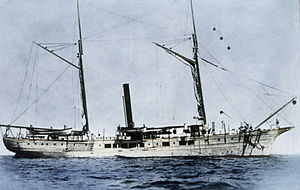USC&GS George S. Blake

USC&GS George S. Blake c.1870s
|
|
| History | |
|---|---|
|
|
|
| Namesake: | Commodore George Smith Blake (1803-1871) |
| Builder: | E. J. Fardy, Baltimore, Maryland |
| Cost: | $84,600 |
| In service: | 1874 |
| Out of service: | 25 January 1905 |
| Fate: | Sold |
| General characteristics | |
| Tonnage: | 182 tons |
| Length: | 148 ft (45 m) |
| Beam: | 26 ft 6 in (8.08 m) |
| Draft: | 11 ft 8 in (3.56 m) |
| Sail plan: | Schooner |
USC&GS George S. Blake, in service 1874-1905, is, with the U.S. Fish Commission steamer Albatross, one of only two US oceanographic vessels with her name inscribed in the façade of the Oceanographic Museum (Musée Océanographique), Monaco due to her being "the most innovative oceanographic vessel of the Nineteenth Century" with development of deep ocean exploration through introduction of steel cable for sounding, dredging and deep anchoring and data collection for the "first truly modern bathymetric map of a deep sea area."
George S. Blake, a steam and sail schooner, was built at a cost of $84,600 in 1874 by E. J. Fardy, Baltimore, Maryland with dimensions of 148 feet 0 inches (45.11 m) length with 26 feet 6 inches (8.08 m) beam and draft of 11 feet 8 inches (3.56 m). It was named after late United States Naval Academy Superintendent George S. Blake.
Among the notable discoveries linked to the ship was the definition of bathymetry proving an unexpected at the time and unusual feature of the United States continental slope, now named for the ship as the Blake Plateau. Initial findings of such a plateau were found in June 1880 during investigations of the Gulf Stream. During her first survey season, starting in June 1874, George S. Blake was being used to test deep sea equipment designed by Sir William Thomson, the Thomson Sounding Machine (also known as the Kelvin sounding machine), as modified by Commander Belknap, USN and to bring up specimens from 2,144 fathoms (12,864 ft; 3,921 m) in the Gulf of Maine. By the time the ship reached the Gulf of Mexico in 1875 under the command of Lieutenant Commander Charles Dwight Sigsbee, USN the ship was using a modification of the Thomson sounding machine designed by Sigsbee, known as the Sigsbee sounding machine that was the standard wire sounding device for fifty years, and with the shot release device first tested the previous year with Sigsbee attached to the survey party.
...
Wikipedia
